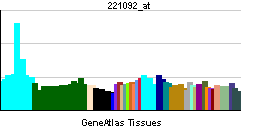IKZF3
| IKAROS family zinc finger 3 (Aiolos) | |||||||||||
|---|---|---|---|---|---|---|---|---|---|---|---|
| Identifiers | |||||||||||
| Symbols | IKZF3 ; AIOLOS; ZNFN1A3 | ||||||||||
| External IDs | Template:OMIM5 Template:MGI HomoloGene: 8269 | ||||||||||
| |||||||||||
| RNA expression pattern | |||||||||||
 | |||||||||||
| More reference expression data | |||||||||||
| Orthologs | |||||||||||
| Template:GNF Ortholog box | |||||||||||
| Species | Human | Mouse | |||||||||
| Entrez | n/a | n/a | |||||||||
| Ensembl | n/a | n/a | |||||||||
| UniProt | n/a | n/a | |||||||||
| RefSeq (mRNA) | n/a | n/a | |||||||||
| RefSeq (protein) | n/a | n/a | |||||||||
| Location (UCSC) | n/a | n/a | |||||||||
| PubMed search | n/a | n/a | |||||||||
IKAROS family zinc finger 3 (Aiolos), also known as IKZF3, is a human gene.[1]
This gene encodes a member of the Ikaros family of zinc-finger proteins. Three members of this protein family (Ikaros, Aiolos and Helios) are hematopoietic-specific transcription factors involved in the regulation of lymphocyte development. This gene product is a transcription factor that is important in the regulation of B lymphocyte proliferation and differentiation. Both Ikaros and Aiolos can participate in chromatin remodeling. Regulation of gene expression in B lymphocytes by Aiolos is complex as it appears to require the sequential formation of Ikaros homodimers, Ikaros/Aiolos heterodimers, and Aiolos homodimers. At least six alternative transcripts encoding different isoforms have been described.[1]
References
Further reading
- Schmitt C, Tonnelle C, Dalloul A; et al. (2003). "Aiolos and Ikaros: regulators of lymphocyte development, homeostasis and lymphoproliferation". Apoptosis. 7 (3): 277–84. PMID 11997672.
- Morgan B, Sun L, Avitahl N; et al. (1997). "Aiolos, a lymphoid restricted transcription factor that interacts with Ikaros to regulate lymphocyte differentiation". EMBO J. 16 (8): 2004–13. doi:10.1093/emboj/16.8.2004. PMID 9155026.
- Wang JH, Avitahl N, Cariappa A; et al. (1998). "Aiolos regulates B cell activation and maturation to effector state". Immunity. 9 (4): 543–53. PMID 9806640.
- Kim J, Sif S, Jones B; et al. (1999). "Ikaros DNA-binding proteins direct formation of chromatin remodeling complexes in lymphocytes". Immunity. 10 (3): 345–55. PMID 10204490.
- Koipally J, Renold A, Kim J, Georgopoulos K (1999). "Repression by Ikaros and Aiolos is mediated through histone deacetylase complexes". EMBO J. 18 (11): 3090–100. doi:10.1093/emboj/18.11.3090. PMID 10357820.
- Romero F, Martínez-A C, Camonis J, Rebollo A (1999). "Aiolos transcription factor controls cell death in T cells by regulating Bcl-2 expression and its cellular localization". EMBO J. 18 (12): 3419–30. doi:10.1093/emboj/18.12.3419. PMID 10369681.
- Hosokawa Y, Maeda Y, Takahashi E; et al. (2000). "Human aiolos, an ikaros-related zinc finger DNA binding protein: cDNA cloning, tissue expression pattern, and chromosomal mapping". Genomics. 61 (3): 326–9. doi:10.1006/geno.1999.5949. PMID 10552935.
- Koipally J, Georgopoulos K (2000). "Ikaros interactions with CtBP reveal a repression mechanism that is independent of histone deacetylase activity". J. Biol. Chem. 275 (26): 19594–602. doi:10.1074/jbc.M000254200. PMID 10766745.
- Perdomo J, Holmes M, Chong B, Crossley M (2001). "Eos and pegasus, two members of the Ikaros family of proteins with distinct DNA binding activities". J. Biol. Chem. 275 (49): 38347–54. doi:10.1074/jbc.M005457200. PMID 10978333.
- Rebollo A, Ayllón V, Fleischer A; et al. (2002). "The association of Aiolos transcription factor and Bcl-xL is involved in the control of apoptosis". J. Immunol. 167 (11): 6366–73. PMID 11714801.
- Liippo J, Nera KP, Veistinen E; et al. (2002). "Both normal and leukemic B lymphocytes express multiple isoforms of the human Aiolos gene". Eur. J. Immunol. 31 (12): 3469–74. PMID 11745366.
- Nakase K, Ishimaru F, Fujii K; et al. (2002). "Overexpression of novel short isoforms of Helios in a patient with T-cell acute lymphoblastic leukemia". Exp. Hematol. 30 (4): 313–7. PMID 11937265.
- Koipally J, Georgopoulos K (2002). "A molecular dissection of the repression circuitry of Ikaros". J. Biol. Chem. 277 (31): 27697–705. doi:10.1074/jbc.M201694200. PMID 12015313.
- Strausberg RL, Feingold EA, Grouse LH; et al. (2003). "Generation and initial analysis of more than 15,000 full-length human and mouse cDNA sequences". Proc. Natl. Acad. Sci. U.S.A. 99 (26): 16899–903. doi:10.1073/pnas.242603899. PMID 12477932.
- Rual JF, Venkatesan K, Hao T; et al. (2005). "Towards a proteome-scale map of the human protein-protein interaction network". Nature. 437 (7062): 1173–8. doi:10.1038/nature04209. PMID 16189514.
- Antica M, Dubravcic K, Weber I; et al. (2007). "A search for a mutation of the Aiolos phosphorylation domain in lymphocytes from patients with leukemia". Haematologica. 92 (2): 260–1. PMID 17296582.
- Ghadiri A, Duhamel M, Fleischer A; et al. (2007). "Critical function of Ikaros in controlling Aiolos gene expression". FEBS Lett. 581 (8): 1605–16. doi:10.1016/j.febslet.2007.03.025. PMID 17383641.
- Caballero R, Setien F, Lopez-Serra L; et al. (2007). "Combinatorial effects of splice variants modulate function of Aiolos". J. Cell. Sci. 120 (Pt 15): 2619–30. doi:10.1242/jcs.007344. PMID 17646674.
External links
- IKZF3+protein,+human at the US National Library of Medicine Medical Subject Headings (MeSH)
| This protein-related article is a stub. You can help Wikipedia by expanding it. |
This article incorporates text from the United States National Library of Medicine, which is in the public domain.